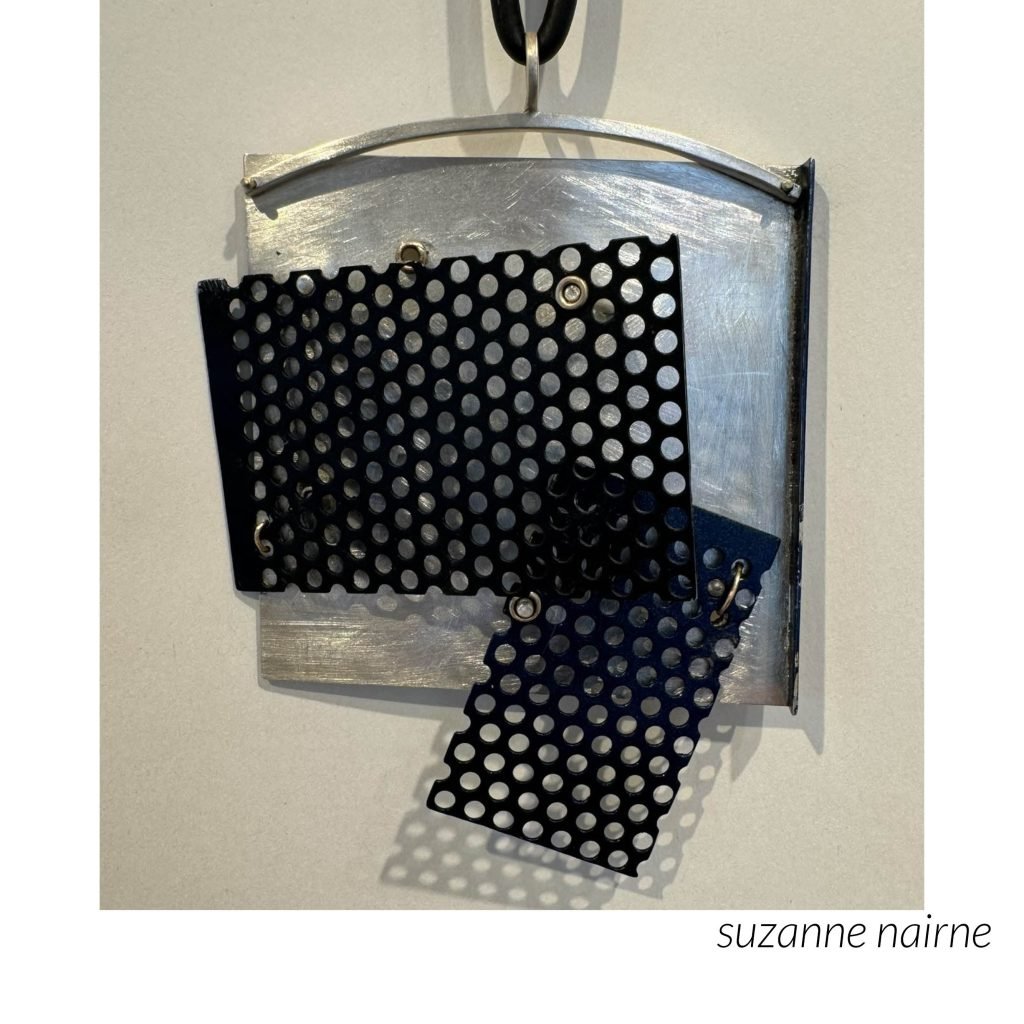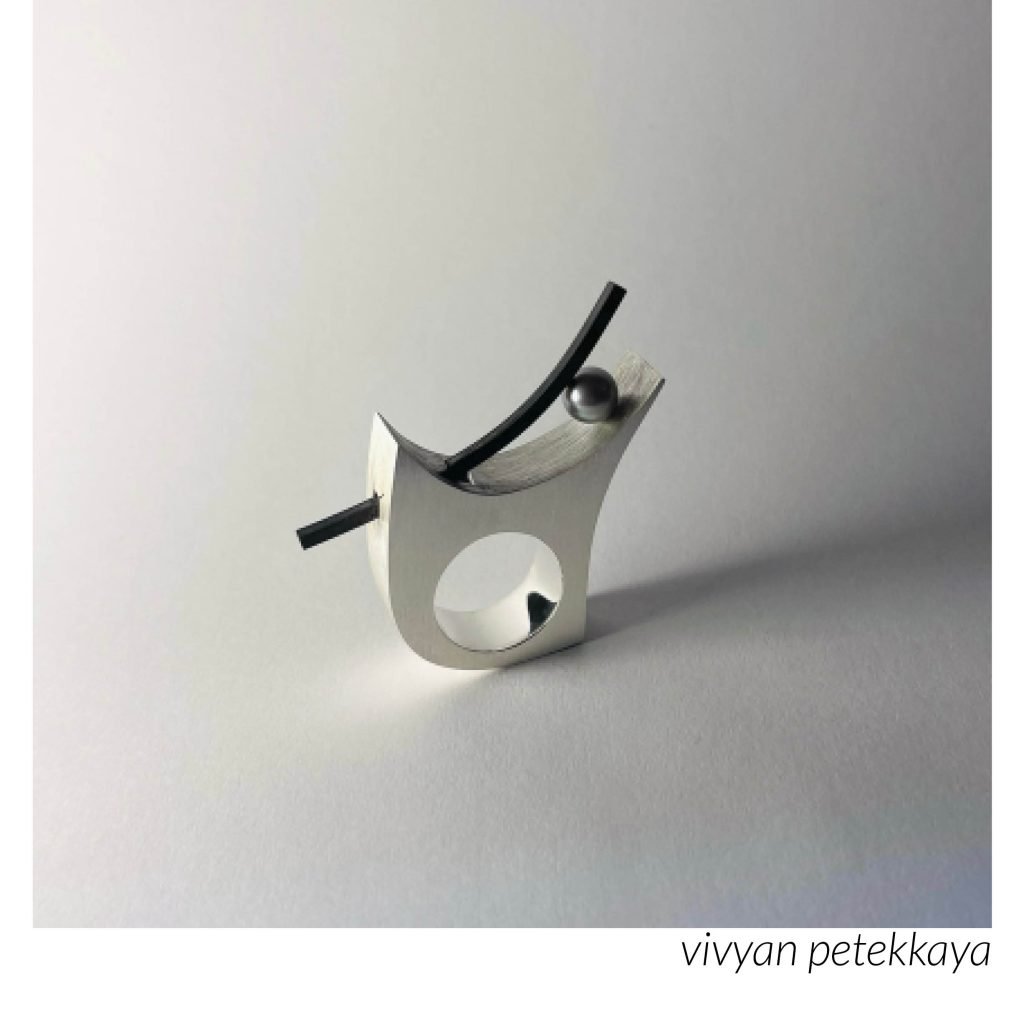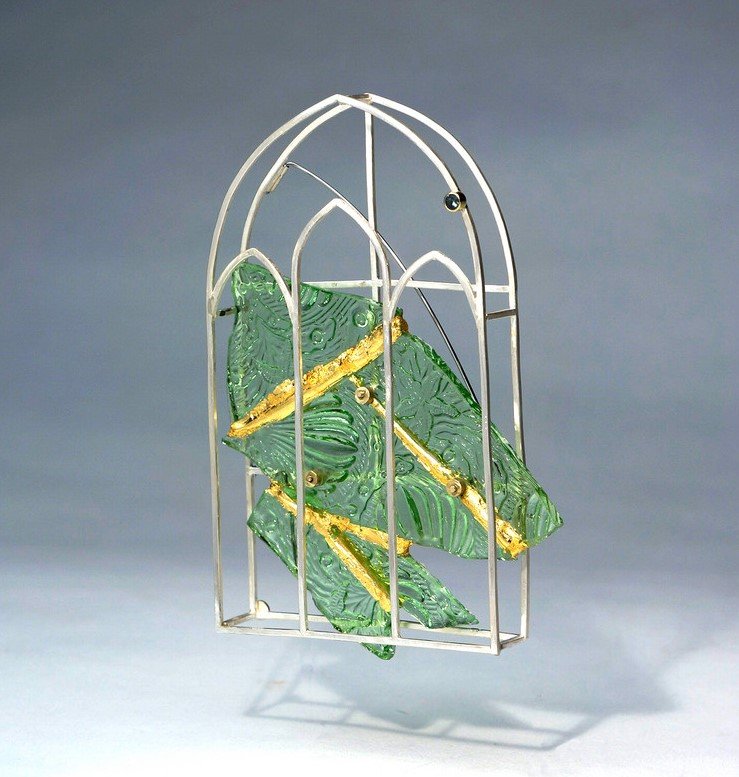The concept of space has long been a subject of interest for many thinkers and has been defined in various ways throughout history based on prevalent social and cultural approaches, including metaphorical language, symbolism, and mythology. The jewelry exhibition organized by the Vancouver Metal Art association, with its theme of “Evolving Spaces,” showcases the work of twenty-four artists, each offering a diverse and colorful response stemming from the minds and perspectives of the participating artists. To critique this exhibition and its works, one must first extract prevalent patterns of thought among artists through semiotic analysis of the artworks and studying their statements.
“The concept of space has long been a subject of interest for many thinkers …“
The author of this critique has delved into uncovering three common patterns in the factors affected by changes in space on humans, based on a mental model and the viewpoints of philosophers and thinkers. These patterns are considered with time as a constant component in space transformations. They include:
Physical and spatial changes:
- Alterations in physical dimensions, such as space shrinking or expanding.
- Spatial displacement, like moving from one place to another or substituting places.
- Introducing changes in physical structures or buildings.
- Environmental changes.
- Temporal-spatial changes like decay and aging.
This pattern can be described in terms of Hegelian dialectics, where each physical or situational domain (thesis, antithesis) has its own constraints and specific contradictions that lead to either escalation or improvement (synthesis). Artworks by Mina Sanei, Suzanne Naine, Melissa Lovingood, effectively utilize this conceptual framework in their ideation.


Emotional or psychological changes in space:
- Shifts in individuals’ feelings towards space, such as feeling constrained or liberated, seeking safety and serenity, or ambiguity.
- Discovery and alteration of perspectives and attitudes.
- Changes in lifestyle and relational habits, as well as cultural challenges.
- Matters of life, survival, and birth, and physiological and identity changes.
Heidegger’s emphasis on the concept of “Dasein” or human existential existence is relevant here, asserting that our existence in the world, particularly in space and time, influences our experiences and emotions. Noteworthy works in this thematic approach include those by Clarissa Long and Viyan Petekkaya.
Social changes in space:
- Changes in human interactions and social dynamics, local communities, and human behaviors.
- Transitions or alterations in population types, such as migration.
- Cultural, linguistic, and identity-related spatial changes.
- Contemporary transformations in social norms over time and the confrontation with modernity and post-modernism.
Eric Fromm and Michel Foucault have extensively examined the role of social structures and contexts in shaping individual identities, precisely addressing this topic. Wang, Sishi’s work is a notable example reflecting this conceptual pattern

By examining these three patterns and delving into the depth of this subject, the critique acknowledges the boldness of exploring such profound human concepts, especially in Canada’s multicultural society. While this theme may be comprehensible and relatable to many, it can also be ambiguous and subject to misinterpretation, highlighting the necessity for such critique and cultural dialogues surrounding this exhibition.
What stood out to me as an achievement in this exhibition was encountering works that remained faithful to cultural and national traditions, both in form and content, while expressing universally human concepts drawn from various cultures and languages through jewelry.

For instance, Meichan Yuan’s creative engagement with the art of Kintsugi (金継ぎ, “golden joinery”) and the theme of human wounds reminded me of Roman saying: “Wounds are the places where light enters the human soul.”
The creation of gothic forms with neutral gray tones in the frame of this work, along with the use of glass and gold materials, primarily invoked a spiritual space that seemed to play a significant role in healing human wounds, based on the threefold patterns presented earlier regarding human encounters with changes in emotional and psychological spaces
Left: Meichan Yuan
Additionally, Abbi Tucker’s remarkable collection, with motifs of snakes and rabbits and a subtle reference to the mythological competition between the snake and the rabbit in Greek and Chinese cultures, addresses important themes such as human weakness and resilience in various life situations and spaces.
The artist’s meticulous craftsmanship in casting wax to create these pieces, along with the artistic expression and ideas behind them, were commendable.
Most of the artists in this exhibition demonstrated bold experimentation with materials and techniques in their work, along with Claudine Gevry’s avant-garde presentation, which was noteworthy.
Right: Abbi Tucker

Furthermore, regarding the selection of works, a notable point for me was the prevalence of brooches compared to other jewelry functions, which may be attributed to either artists’ preferences for expressing contemporary ideas or the curatorial approach in selecting works. Or it may be a deliberate choice by artists to convey concepts more consciously through jewelry.
The only aspect that seemed lacking in the exhibition’s organization was the detachment of statements from the viewers’ perspective. Because of the behavioral psychology of viewers at exhibitions, reading statements alongside artworks would have made it much easier than reading them online or on smart devices.
However, in terms of layout, the use of paper rolls and invisible threads, as well as the creatively suspended showcases, was intelligent and resourceful, given the limited space and number of works. The number of works or pieces was acceptable and sufficient, especially considering this was the first experience of an open call for an exhibition.
In conclusion, my overall evaluation of the contemporary jewelry exhibition with the theme of evolving spaces is that it is a artistic journey guiding us into the depths of new perspectives and reflections on life and our surrounding environments. This exhibition vividly demonstrates, through artistic expression and inspiration, how contemporary artists grapple with complex and vulnerable themes such as spatial changes and manifest them creatively through the language of jewelry.
Mohammadhossein Sharifi
Researcher and lecturer in jewelry

